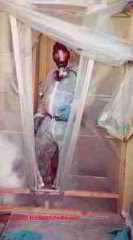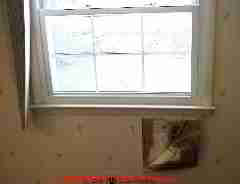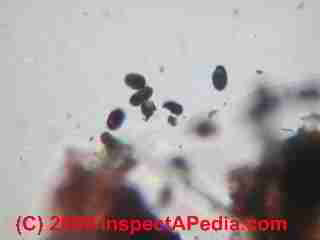 Don't Rely on Bleach for Mold Remediation
Don't Rely on Bleach for Mold Remediation
Mold Remediation Mistakes to Avoid
- POST a QUESTION or COMMENT about cross contamination during mold remediation
Mold cleanup job mistakes: relying on bleach to kill mold.
Here we explain how as relying on bleach to kill mold is by itself an unreliable mold remediation procedure that is not recommended. The proper objectives of an effective mold remediation job are to remove moldy materials that can't be cleaned and to clean surfaces that can be cleaned.
Bleach, diluted bleach, or bleach sprays used in cleaning may be appealing but they are unnecessary, potentially dangerous (if you get bleach in your eyes), and the use of bleach tends to lead to improper and inadequate cleaning - if you substitute "spraying bleach" for actually cleaning or removing the mold your cleanup will not be successful.
InspectAPedia tolerates no conflicts of interest. We have no relationship with advertisers, products, or services discussed at this website.
- Daniel Friedman, Publisher/Editor/Author - See WHO ARE WE?
USING BLEACH - Bleach as a "Mold Medicine" to try to kill mold or prevent mold in buildings
[Click to enlarge any image]
Leaks at the window (photo at left) led to mold growth behind wallpaper as well as in the wall cavity. Surface cleaning of the wall was ineffective and occupant complaints continued in this building.
The object of mold remediation is to clean, or remove, the majority of the mold particles (spores, conidiophores, hyphae, mycelia) from the target surface.
The operative word to fix in mind is to "clean" or "remove" the problem mold.
"Killing" the mold is not the correct objective
- First of all because our lab work shows that you're unlikely to kill all of the mold on a surface using bleach, unless you use it at a concentration and duration which is so strong that you're likely to completely destroy the "bleached" material,
- Second of all because even if you could
"kill" every mold spore, you are at risk of leaving toxic or allergenic particles in place - they may be dead but still
toxic.
See MOLD KILLING GUIDE for details
Our photo shows nice healthy black Stachybotrys chartarum spores collected from a "mold-killing bleach" treated surface in a building.
Finally, "mold removal" only works if you're cleaning a relatively hard, non-porous surface such as finished wood, painted metal, or plastic.
Soft materials like Sheetrock™ or drywall which have become moldy generally should be removed, the exposed surfaces cleaned, and then new drywall can be installed (after you've also corrected the reason for the mold growth in the first place).
Spraying anything if spraying of fungicides or sealants is to be used in place of actual cleaning or removal of mold is an improper and inadequate practice which risks leaving a reservoir of toxic or allergenic particles in the building.
MOLD CLEANUP with BLEACH for details about using bleach to clean up or treat moldy surfaces.
...
Continue reading at RELYING on OZONE to KILL MOLD or select a topic from the closely-related articles below, or see the complete ARTICLE INDEX.
Or see these
Recommended Articles
- DISINFECTION of BUILDING SURFACES
- MOLD ACTION GUIDE - WHAT TO DO ABOUT MOLD
- MOLD CLEANUP GUIDE- HOW TO GET RID OF MOLD - home
- MOLD CLEANUP - MISTAKES to AVOID
- MOLD KILLING GUIDE
Suggested citation for this web page
RELYING on BLEACH on MOLD at InspectApedia.com - online encyclopedia of building & environmental inspection, testing, diagnosis, repair, & problem prevention advice.
Or see this
INDEX to RELATED ARTICLES: ARTICLE INDEX to MOLD CONTAMINATION & REMEDIATION
Or use the SEARCH BOX found below to Ask a Question or Search InspectApedia
Ask a Question or Search InspectApedia
Try the search box just below, or if you prefer, post a question or comment in the Comments box below and we will respond promptly.
Search the InspectApedia website
Note: appearance of your Comment below may be delayed: if your comment contains an image, photograph, web link, or text that looks to the software as if it might be a web link, your posting will appear after it has been approved by a moderator. Apologies for the delay.
Only one image can be added per comment but you can post as many comments, and therefore images, as you like.
You will not receive a notification when a response to your question has been posted.
Please bookmark this page to make it easy for you to check back for our response.
IF above you see "Comment Form is loading comments..." then COMMENT BOX - countable.ca / bawkbox.com IS NOT WORKING.
In any case you are welcome to send an email directly to us at InspectApedia.com at editor@inspectApedia.com
We'll reply to you directly. Please help us help you by noting, in your email, the URL of the InspectApedia page where you wanted to comment.
Citations & References
In addition to any citations in the article above, a full list is available on request.
- In addition to citations & references found in this article, see the research citations given at the end of the related articles found at our suggested
CONTINUE READING or RECOMMENDED ARTICLES.
- Carson, Dunlop & Associates Ltd., 120 Carlton Street Suite 407, Toronto ON M5A 4K2. Tel: (416) 964-9415 1-800-268-7070 Email: info@carsondunlop.com. Alan Carson is a past president of ASHI, the American Society of Home Inspectors.
Thanks to Alan Carson and Bob Dunlop, for permission for InspectAPedia to use text excerpts from The HOME REFERENCE BOOK - the Encyclopedia of Homes and to use illustrations from The ILLUSTRATED HOME .
Carson Dunlop Associates provides extensive home inspection education and report writing material. In gratitude we provide links to tsome Carson Dunlop Associates products and services.



